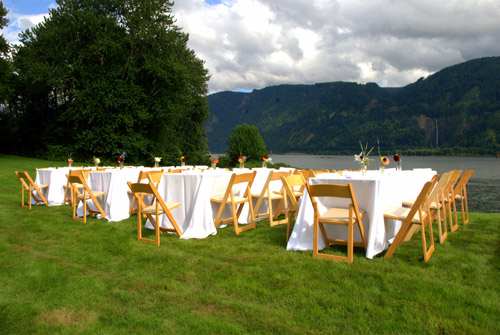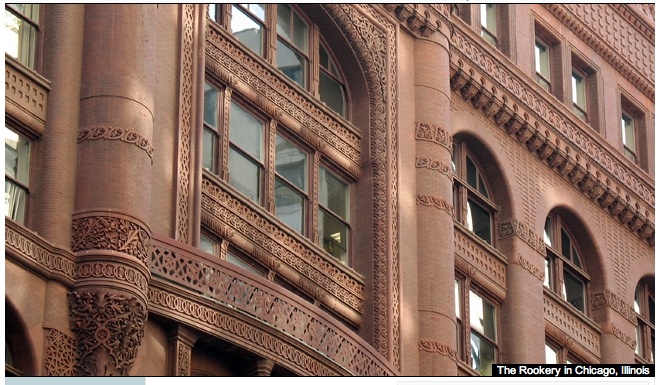On July 15, 2012 Randy Gragg, editor-in-chief of Portland Monthly magazine and Robert Melnick, director of the Yeon Center, co-hosted Picnic at The Shire. The Shire is a 75 acre property designed by and formerly owned by John Yeon, one of the Northwest’s most celebrated designers. Completed in 1989, it is in a style reminiscent of an 18th century English landscape garden.
Picnic at The Shire was a benefit to raise funds for the Yeon Center at the University of Oregon. The Yeon Center owns The Shire in addition to Yeon’s Portland-located Watzek House, and Cottrell House. After Yeon died in 1994, The Shire was donated in 1995 by the John Yeon Trust, the Watzek House the same year by Richard Louis Brown, and the Cottrell House in 2008 from the Cottrell family. The University of Oregon took full responsibility for the Watzek House in 2010. Yeon Center director, Robert Melnick notes,
“The Yeon Center provides a great opportunity for students and the general public to understand not only John Yeon’s extraordinary work, but the importance of regionalism is design. John’s work – whether in architecture, landscape design, environmental activism, and furniture making – was inextricably tied to the Pacific Northwest. He understood the essential integration of those efforts.”
Melnick goes on to illuminate the responsibilities and role of the Yeon Center,
“The properties under the responsibility of the Yeon Center provide us with a unique opportunity to practice the best preservation efforts, and to teach those to our students. At times, this includes long-range preservation and conservation planning, while at other times it requires immediate responses to pressing problems that any homeowner or property owner might have, such as minor leaks, or plumbing or heating issues. Our goal is to complete these projects using the very best and very latest preservation principles and practices, thereby ensuring protection of the properties for generations to come. It is truly an honor to be able to care for such remarkable and important places.”
Tours of The Shire were held throughout the mid-July weekend. Together with the tours, Picnic at The Shire was a collaboration between Randy Gragg’s Portland Monthly magazine and University of Oregon School of Architecture and Allied Arts. In a generous gesture of support and collaboration, Portland Monthly and Randy Gragg are donating all proceeds from the weekend to the Yeon Center.
Frances Bronet, Dean of the University of Oregon School of Architecture and Allied Arts responded to this collaboration observing,
The Yeon Center can be seen as a leader connecting those extraordinary visceral experiences specific to the Pacific Northwest, and epitomized by Yeon’s work…connecting elements of the built and transforming environment. Taking on both Robert Melnick’s and Randy Gragg’s charge to both steward the intersection of landscape and building, as well as inspire a seamlessness of beauty and ecological care.
When asked to comment on the collaboration, Melnick expressed gratitude to Gragg and the Portland Monthly connection.
“Portland Monthly, and especially it’s editor-in-chief Randy Gragg, have been great supporters of the Yeon Center’s efforts to expand the knowledge and appreciation of John Yeon’s pioneering effort, both at the Watzek House and The Shire.” Melnick continued, “Randy has been especially generous with his ideas and initiatives.”
What follows is the story of the event, a glimpse into what was a truly amazing evening. 18th century poet, William Mason wrote several works about the wonder of the English landscape garden and was influential in advancing the idea of the picturesque in a landscape. His sonnet below begins our discussion of Yeon’s Shire, as it sets the stage for our foray into a landscape design philosophy that is both “liberal though limited, restrained though free.”

Smooth, simple path! Whose undulating line,
With sidelong tuffs of flowery fragrance crowned,
“Plain, in its neatness,” spans my garden ground;
What, through two acres they brief course confine,
Yet sun and shade, and hill and dale are thine,
And use with beauty here more surely found,
Than where, to spread the picturesque around,
Cart ruts and quarry holes their charms combine!
Here, as thou leads’t my step through lawn or grove,
Liberal though limited, restrained though free,
Fearless of dew, or dirt, or dust, I rove
And own those comforts all derived from thee!
Take then, smooth path, this tribute of my love,
Thou emblem of pure legal liberty!— A sonnet by William Mason, from The Oxford Book of Garden Verse, reprinted in Perspectives on Garden Histories
The July 15th mid-summer afternoon spread out upon John Yeon’s Shire with a myriad of weather possibilities. Glorious Gorge sunshine was tempered by billowly, smoke-gray clouds reaching into shades of navy, while a soft breeze blew that anyone with Gorge-savvy knows could switch to gale force in minutes. Roughly a half hour drive eastward on Highway 14 out of Washougal, Washington, The Shire is carefully tucked away behind a screen of thick forest and a lone, single bar metal gate. This modest entry draws you down a path-like driveway that winds its way brushing by lush bracken, below cathedral canopies of tree foliage, and along surprise reveals of capricious meadows, streams and ponds. Anticipation for what awaits builds. This suspense yields to curiosity as the driveway, with a Gorge-like windy rush, gives way to an expansive lay of grass, an elevated horizontal berm. In almost art historical text-book form, and in a brilliantly planned moment of design genius, a ground line is formed by the top of this berm catching Multnomah Falls, a small perpendicular vision far away across the Columbia. Walking to the top of this knoll and captivated by the view, remembrances of English poet William Mason’s “one ample theatre of sylvan grace” (English Garden: A Poem in Four Books, Book 1, line 548, 1786) comes to mind, an essential feature of the 18th century English landscape garden. Into this autochthonous scene (a term used to describe indigenous aspects of the 18th century English landscape garden), The Shire is a landscape garden furnished with countless features of a natural landscape only one of which is this first introduction to the theater. The “amphitheater” [from Gragg’s Portland Monthly article, The Long View] is an en plein air setting, a strappingly thick arc of land inviting the river to smoothly swirl in and approach visitors. This is your first indication that The Shire will unfold like a painting, gloriously saturated with Arcadian charm, a place where reality and the ideal seamlessly blend.
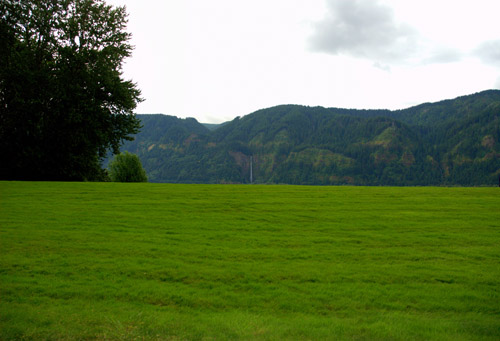
This afternoon, The Shire looked nothing short of basking in promise—freshly primped and trimmed. I arrived expecting greatness, and was greeted by Randy Gragg, co-host of the Picnic; I was also welcomed by a bustling staff from the Art of Catering who were fully mobilizing to create the fabulous evening meal. Bouquets of fresh flowers, bottles of uncorked wine, and the epicurean smells of what lay ahead made it clear no stone had been left unturned, this was definitely about to be an extraordinary event.
Gragg wandered off to, as he put it, “get reacquainted” with nearby recently mowed walks and I got the distinct feeling he was in a nostalgic mood eager to enjoy a landscape that to him was like an old, dear friend. Somewhat pleased at being left alone, I turned my attention to the swelling knoll of green laid out before me.
Under the afternoon’s tenuous skies, presided over by Washington’s craggy south-facing basalt-striated precipice and Oregon’s north-facing Gorge cliffs down which cascade the misty Multnomah Falls, a bashful Bridal Veil Falls and delicate wispy of a falls with a name I do not know, sits The Shire. As a landscape, The Shire appears quiet, calm and self-assured. Its prominent features available to explore via politely trimmed paths and a kind consideration to all blooming plants. Equal prominence is given to the lace cap baby blue hydrangea as is to the wild sprawling hot pink sweet peas. Every growing thing has space to express an individual beauty. The prevalent sense was that Yeon had an appreciation for nature’s habit of embracing variety, excess, and a lovely sense of balanced disorder.
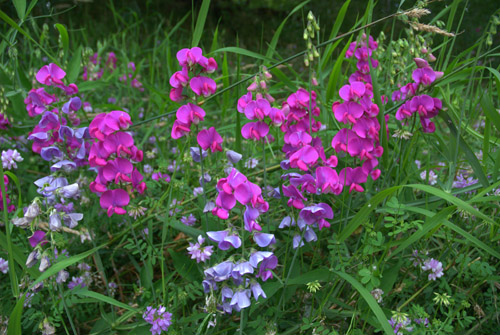
The curving composure of The Shire’s most prominent feature, that gorgeous arcing riverbank lies almost as if in wait, comfortably content to be rediscovered, to be appreciated for its languishing splendor. This was four o’clock in the afternoon. Within the next hour and as the sun played with the idea of appearing and disappearing, about 70 guests, would arrive to converge on this pristine riverbank and experience The Shire, many discovering this place for the first time.

There is an important heritage to The Shire site that helped propel guests to attend the exclusive event. Gragg describes it as “the heritage of everyone who enjoys the Gorge.” Taking his cue from the women of the Portland Garden Club who originally gathered for the first Yeon picnics at The Shire in the 1980s (organized to garner support for the Columbia River Gorge environment), Gragg conceived the idea of the Picnic event and initiated the attendance of seven of those original PGC women who had been part of that first “Committee to Save The Columbia River Gorge.” Gragg comments, “it’s imperative to bring these kinds of histories to life….in a phrase, [Picnic at The Shire] was a celebration of elders.” It had been these women supporters who two decades ago would come to play a key role in ensuring the Gorge would thrive. Gragg describes this group of conservation activists as, “the proto-version of Friends of the Columbia River Gorge.” This afternoon, Mary Bishop, Susan Bodin, Nancy Frisch, Betsy Smith, Marie Hall, Dottie Schoonmaker and Pat Wall were the esteemed seven. Their participation substantially enriched the evening’s conversation.
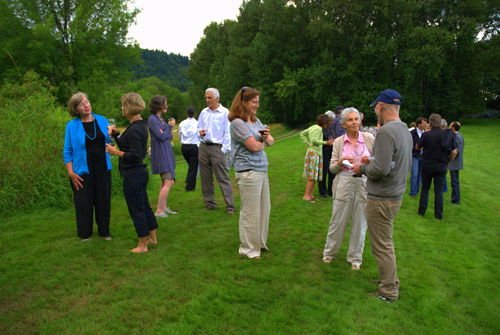
Among others in attendance were Anthony Belluschi, son of Yeon contemporary, Pietro Belluschi, (another true Oregon luminary); Brian Ferriso, director of the Portland Art Museum; Zari Santner, former director of Portland Parks and Recreation; Tom Manley, president of Pacific Northwest College of Art; Kate Wagle, interim vice provost of UO Portland and director of the UO School of Architecture and Allied Arts in Portland; and landscape architects Doug Macy and Steve Koch; not to mention newcomers and outliers such as brand consultant Chris Riley and venture capitalist Steven McGeady. Everyone was particularly thrilled to see Lewis MacArthur, editor of Oregon’s Geographic Place Names.
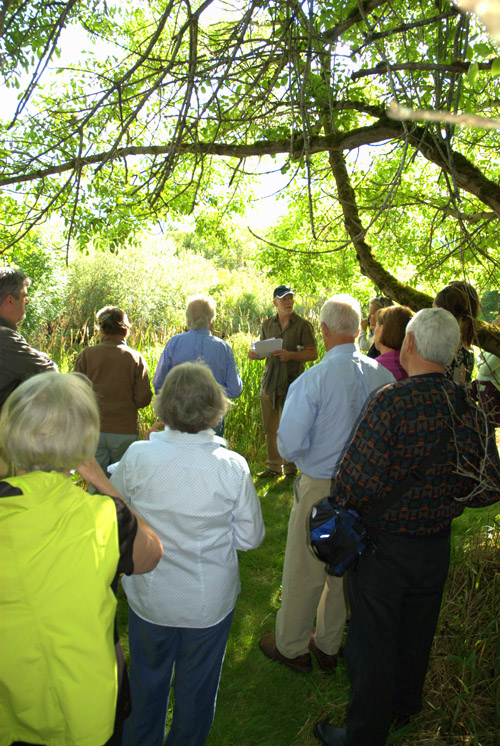
With the guests having arrived, we turned all attention to our guides, Randy Gragg and Hannah Bryant, current Yeon Center graduate teaching fellow. I was allocated to Gragg’s group and so we moved in the direction of the setting sun finding ourselves on a path that ended with a curving tree branch right at eye level and a surprising view directly behind of the river, a yellow floating bridge and a creek gurgling into the vast Columbia. We were introduced in that very moment to Yeon’s captivating penchant for ‘garden folly’….and as the group collectively became mesmerized by this clever manipulation of our view, Gragg began to enlighten us.
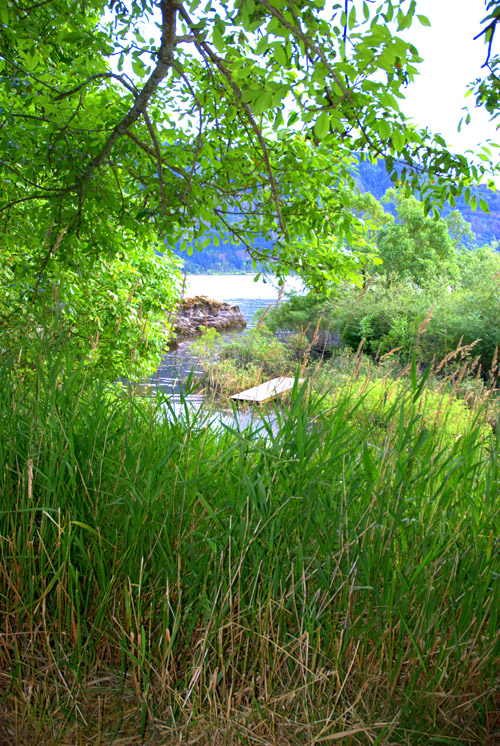
Gragg explained Yeon’s sensitive touch that brought to the landscape a sense of the “inverted picturesque” and a wistful “nostalgia.” Experimental in carefully and subtly diverting streams to create creekside walks that culminate in viewpoints, Yeon has given us a place to pause and notice the natural: places Gragg refers to as “the follies,” reminiscent of the term “folly” as it applies to a traditional English landscape garden, a feature within the landscape used primarily for decoration. At The Shire Yeon shaped the land with less-than-delicate tools, a bulldozer, a chainsaw, adding plantings along the way. But even with these machines of modernity and ruggedness, Yeon’s vision created a picturesque landscape and elevated natural, not architectural, features to the status of folly.
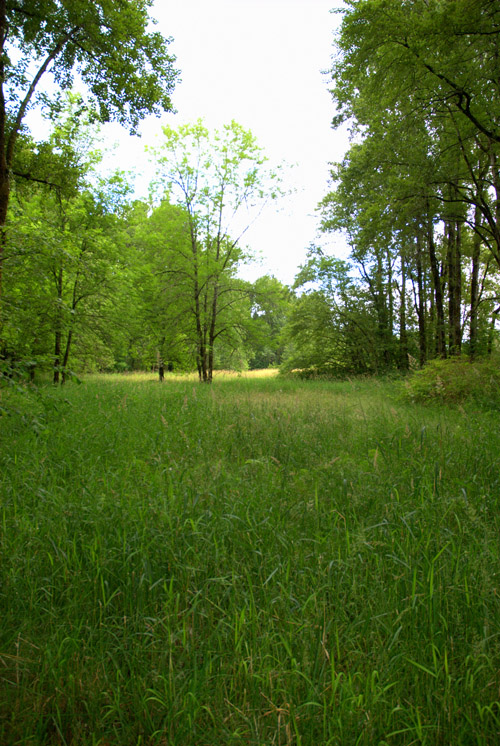
Each thoughtfully crafted peek of waterfall or framed vista of landscape, is an “ode to the Gorge,” continued Gragg. In other words, this is a garden where each view confides an aspect of enlightenment and wisdom. If we are to examine The Shire as Yeon intended, we need to look at this, suggests Gragg, as “a metaphor for how Yeon thought the Gorge should be treated.” Gragg gently prompted us to see in these crafted spaces, open to the sky, a testimony and appeal for the care and consideration Yeon so desperately longed to happen for all the Gorge. Yeon’s mission, Gragg pointed out, was to ask Portlanders, and beyond, to think about the landscape as a canvas that if painted upon needed to be done so with great consideration and thought for both what would be changed and what would remain untouched.
Gragg continued explaining Yeon’s theory: “if you are going to touch the land at all you need to design it.” Yeon’s great aspiration for his Shire was for this landscape and the Gorge to be a national park. But this dream proved quixotic as Gragg touched upon: the Washington side of the river would remain more about industry not environmental preservation.
As our little group walked, commented, and wondered aloud, Gragg talked, encouraging and responding to individual questions with the knowledge and expertise given to him by his connection to the designer and years spent lecturing and writing about Yeon. Gragg painted a vivid picture of Yeon, the consummate gentleman, intellectual, handsome, with piercing blue eyes, a striking figure. The vision was one of the slightly eccentric, English country squire-like, educated, creative, outspoken but reserved, appreciative of his surroundings, an arts and culture partisan able to appreciate the unusual as well as the commonplace; and to embrace both Western and Eastern cultures, (Yeon called the Columbia River Gorge “my Chinese landscape”).
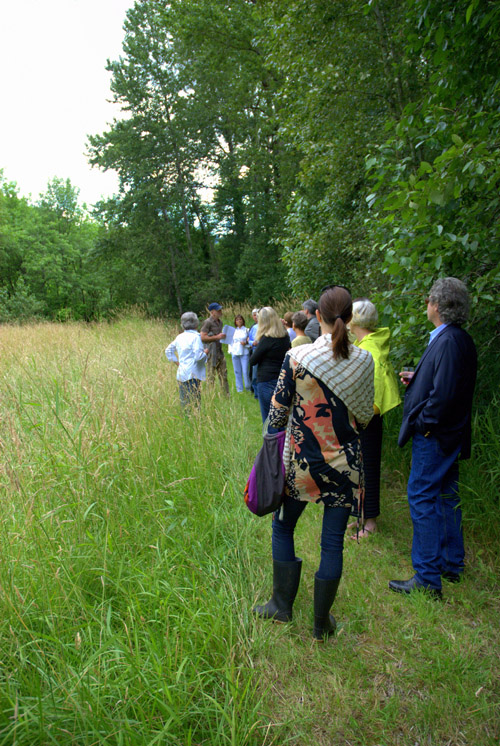
With a new understanding of the person that was Yeon, Gragg prompted us to move on to new discoveries in the landscape. Stopping at a small meadow, Gragg gestured to the flaxen colored grasses and turned to address Yeon’s design aesthetic. “See,” Gragg explained, “Yeon’s design was very much about compression and release.” First, we are suppressed by a Tolkien-like forest-winding walk heavy with trees overhead and dark with overhanging foliage, and restricted light; then we are liberated by a flowing meadow expansive in all directions. As a comprehensive work of art, The Shire shows a sense of liberty balanced by a sense of restraint; perhaps providing a moral stage as if to lecture on the story of preservation and conservation.

Gragg concluded his tour by leading the group into yet another meadow, this time we stood expectantly ready to admire the beauty of the simple, vegetation-surrounded, circular meadow. But, in customary Yeon form, we should have realized there would be so much more. Gragg said to us, “Now if you would all turn around,” he cast his gaze behind us. Turning to the south, we saw a well-trimmed, tall and precariously narrow key-hole parting of the trees revealing a perfect view of Multnomah Falls clear across the river—a long view to the Oregon side of things and an insightful opening up of the possibilities and relationship between both sides of the river. Showing us this snipet of perfection, the last piece of The Shire completed in 1989, Gragg quietly declared, with a nostalgic smile, “The folly is the falls.” And as numerous smartphone cameras were raised by their holders in silent capture of this last meaningful drama of The Shire, we were confronted with the realization that this precious resource is fragile, in constant need of well-planned maintenance and care if Yeon’s painterly vision is to be sustained. Indeed, it befalls upon us as guardians of our great Northwest environment to recognize Yeon’s contribution and keep it as he would have wished, as he was the ultimate caretaker with purely selfless visions for the Gorge. Yeon was instrumental in forming this priceless painting of his Columbia River hideaway, it is has been trusted to the Yeon Center to preserve and protect.

I discussed future of The Shire with a few of the original garden club women looking to discover their thoughts about the landscape. Some remembered it differently than it was today. Having picnicked in this landscape years ago and having a sense of the nostalgia for the place, the original group expressed great affection for the memory of Yeon’s touch on the landscape. Yeon’s own keen aesthetic sense guided the clipping, pruning, and cutting that cultivated this place and that might be lost forever without listening to those who have experienced this place in its prime. One woman commented with a bit of melancholy, that she recalled how Yeon used to mow the grass so as to produce a beautiful woven pattern in the cut lines. She hoped this would be remembered and done again; it was the little details that seemed to matter the most in the memories of The Shire’s early days.

Our evening wound down while the river played catch-up with the sea, the sun played hide-and-seek with a heavenly cumulus, and a few drops of rain nourished The Shire’s flora and fauna. The privileged guests of the first Picnic at The Shire, 2012 sat down to dinner at white-clad tables, the clink of cutlery and dishes, and the warm tones of content conversation filling the balmy evening.
As guests enjoyed the beautiful meal, merely across the river, and barely audible on The Shire side, the hum of summer traffic on I-84 was an inescapable reminder of the fight Yeon had led to transform the highway department’s planned straight, rigid road to curve and flow with the contours of the river, being ever respectful to the existing river path. Due to Yeon’s efforts, the road that exists today is much more sensitive to the river’s countless years’ journey carving out a path of least resistance.
Part of Yeon’s vast creative genius lies in his acute awareness of what it takes to get us to stop and notice a simple framing of a scene that reveals information about a place. The Shire’s vistas of far-off waterfalls, panoramas of meadows, hobbit-like wanderings through lushly mysterious forest—these are all features shown to us in enchanting ways, the “follies” of Yeon’s landscape. When you visit The Shire these vistas of pure brilliance and escape are, like Gragg so aptly describes, a landscape of “compression and release” with focal points designed to inform. The Shire is where Yeon in his craft and artful ways, with great enlightenment but never missing the drama and the magnificence, and like William Mason’s garden sonnet, always “liberal though limited, restrained though free” shows us just how great this place is. The Shire is one of our region’s finest treasures, a garden, “the purest of human pleasures; ….the greatest refreshment to the spirits of man.” [William Mason, English Garden: A Poem. In Four Books, 1786].
Taking the quips and conversation overheard from the original seven supporters, the Shire, might even be said to have offered similar enchanting sights and smells on the July 15 Picnic that it had each day, of each season since 1989—just enough to evoke the nostalgic conversations of the garden club ladies, and, indeed, that of our tour guide as well. Yeon was an impeccable expert on this tutelage of the natural, and sensitivity to the environment. So beautifully does he guide us to awareness, compassionately revealing that sometimes nature has to be sculpted, crafted, or framed in such a way as to be put on display. The Shire is a sanctuary of crescent river banks, flourishing meadows, meandering footpaths and charming reminders of how to appreciate the magnificence of nature. Into this landscape, Yeon’s legacy seems carried on the winds of the Gorge, with the potential to be either fleeting or strong and steady. We can wonder how it used to be those 20+ years ago when Yeon invited his first, and perhaps most influential guest, Nancy Russell to the evening picnic that launched a wave of conservation effort [read about Yeon’s connection to Nancy Russell and his Columbia Gorge preservation efforts in The Long View]. Does the river smell the same wet, sweet earthen? Did the ospreys glide overhead on river drafts? Did similar soft breezes explore the Gorge’s craggy cliffs and the same robust green of freshly cut grass infuse the air? The same grasses growing that once supported the Persian rugs laid down to comfort Yeon and his picnic guests? Were the liberating spaces in the trimmed trees as wide, as long, or perhaps even more revealing? What can we do to ensure this places thrives yet remains true to Yeon’s vision? With the existence of the Yeon Center, we have the ability to recreate, or as Gragg encourages, to revive the Yeon aesthetic and keep it pristine. I asked Gragg to comment on the need to plan, preserve and protect The Shire and the existence of the Yeon Center as a vehicle to make that happen. Gragg said,
“The Yeon Center is very much a work in progress. Robert Melnick did a great job of landing the properties, figuring out how the university could be stewards, and getting the Watzek House listed as a National Historic Landmark. Programming is the obvious next step. I think there are two questions: how does it enrich the university community and AAA’s pedagogy? But also how can it inspire the region? Every fiber of John Yeon’s will was devoted to designing and advocating for Oregon’s beauty and sustainability—two words that, to him, were synonymous. That seems like a mighty fine mission statement for some organization because, right now, none exists. Maybe its the Yeon Center.”

The University of Oregon’s Yeon Center has in Professor Melnick and Randy Gragg invaluable resources and champions of all things Yeon. As Dean Frances Bronet commented, the Yeon Center “[takes] on both Robert Melnick’s and Randy Gragg’s charge to both steward the intersection of landscape and building, as well as inspire a seamlessness of beauty and ecological care.” Through the Yeon Center, both Melnick and Gragg have made a significant difference in educating the public and academically oriented university students about Yeon’s legacy and have successfully worked to keep this highly creative design genius in an Oregon, and, indeed national spotlight.
During his years as an art and architectural critic and, now as Portland Monthly editor-in-chief, Gragg has magnanimously devoted great quantities of ink to championing Yeon as an icon of the Northwest designed environment. In seeking to open our eyes to Yeon’s design philosophy and aesthetic, Gragg effectively has helped to preserve and promote key Yeon spaces and places consistently reminding his audience that Yeon has had an incredible positive impact on our region that can continue if we are educated of Yeon’s work and legacy. Gragg met Yeon in 1992, visiting both The Shire and the Watzek house with Yeon as his tour guide and confidante. The respect and admiration Gragg feels for Yeon and the understanding he has for Yeon’s design aesthetic is nothing short of impressive and translates well in Gragg’s lectures, writings and, indeed, heartfelt remembrances of Yeon, both in general fact and anecdotal detail. Perhaps a meeting of mutual admiration, the Yeon and Gragg camaraderie established in those early visits, seems destined to help preserve Yeon’s fundamental greatness and lasting heritage. In Gragg, Yeon would connect with an empathetic and attentive listener and gain the attention of someone passionately devoted to sustaining and understanding Yeon’s significant contributions to the Northwest region. Gragg comments about his initial 1992 meeting with Yeon and his involvement with the Yeon Center,
“I became fascinated with [Yeon’s] work and story—and increasingly over the years with his lesser-known early work in planning and his life-long behind-the-scenes advocacy for landscape design and historic preservation. I’ve written and lectured about him numerous times over the years. I served on advisory board to the Yeon centers at UO for two years.”
Well-connected and well-informed, Randy Gragg is in a springboard position to advocate, promote, and educate, not to mention connect and network for topics he feels are of relevance to this region. With his commanding post at Portland Monthly, and with the significant distribution of the magazine to an enthusiastic and receptive audience, Gragg found he could truly make a difference in providing information about our history, our icons, our places, and our community. Appreciating this opportunity and with a willing publisher, Gragg realized an occasion to offer to partner with the University of Oregon to help benefit the Yeon Center and bring his passion for Yeon advocacy to a broader audience. It would be a collaboration that would educate his PM readers about something truly special in their environment, something of great relevance to Gragg, himself, and help solidify the well-deserved place of Yeon in Northwest history and culture, not to mention financially benefit the Yeon Center, all Picnic proceeds going to the center. The UO Portland Monthly collaboration has helped to increase knowledge and awareness of Yeon’s work and reached out to embrace an hospitable, and new, perhaps younger audience. It was by no means a coincidence that the Picnic event arrived shortly after Portland Monthly released an issue focused on the Columbia Gorge featuring an article written by Gragg on John Yeon and specifically addressing The Shire, (see The Long View).
As Gragg explains,
“When we have opportunities, I like to extend [Portland Monthly’s] content into the world by inviting people to experience the places we write about. What better match to a cover-feature on the Columbia Gorge and the role the Shire played in its preservation than tours and a dinner at the Shire!”
I asked Robert Melnick to offer a comment on the Yeon Center as a closing to this post looking both to the future and to the past, and in the words of Randy Gragg, across the river to the long view:
“The dinner on July 15 was just one example of the work of the Yeon Center. The Center has a primary responsibility to protect and preserve the Watzek House, The Shire and the Cottrell House, but also to educate others about these remarkable designs. We do this first at the University of Oregon, for students studying architecture, landscape architecture, interior architecture, product design, art, and historic preservation, through tours, lectures and publications. We also open the Watzek House and The Shire to public tours, through which interested professionals and the general public can fully understand and appreciate this work.
[The author expresses many sincere thanks to Randy Gragg for his insightful tour of The Shire and his comments for this post, and to Robert Melnick; as well as to Portland Monthly staff and the UO AAA for her seat at the Picnic at The Shire table.]
Read more about John Yeon:
PortlandModern’s John Yeon biographical sketch
John Yeon, The Oregon Encyclopaedia
Randy Gragg’s article in Portland Monthly, The Long View
Brian Libby’s Portland’s Secret Eden in the blog, Portland Architecture
Sources:
Randy Gragg, email responses to questions prepared by the author.
Robert Melnick, email responses to questions prepared by the author.
Mason, William, M.A., English Garden: A Poem. In Four Books, 1786. (Web)
About Randy Gragg: For over a decade Gragg wrote on architecture for the Oregonian before becoming editor in chief of Portland Monthly. A 2005-06 Loeb Fellow at Harvard University’s Graduate School of Design, he has long championed Yeon’s place in Northwest history: as an architect, but also as a historic preservationist, a conservationist, and one of the primary players in the protection of the Columbia Gorge.
About Robert Melnick: Professor Melnick is the first director of the Yeon centers. He was dean of the School of Architecture and Allied Arts from 1994-2005 and was responsible for securing the donation of the Yeon properties and its endowment for the school. Melnick is a nationally respected expert on cultural landscapes and preservation issues. He has been on the UO faculty since 1982.
